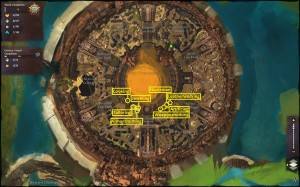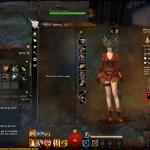 The crafting system is divided into specific crafting professions called disciplines. Each discipline has 400 skill points.
The crafting system is divided into specific crafting professions called disciplines. Each discipline has 400 skill points.
There are eight crafting disciplines:
- Weaponsmiths craft daggers, hammers, greatswords, maces, shields, sigils, spears and swords.
- Huntsmen craft harpoon guns, longbows, shortbows, pistols, rifles, torches, warhorns and sigils.
- Artificers craft scepters, tridents, staffs, foci, sigils and potions.
- Armorsmiths craft Heavy armor, inventory boxes and runes.
- Leatherworkers craft Medium armor, Inventory packs and runes.
- Tailors craft Light armor, inventory bags, and runes.
- Jewelers craft Ring, Amulets, earings, you can also transmogrify gemstones into higher levels.
- Cooking can prepare food which characters can eat for temporary combat buffs.
A character can have two crafting disciplines active at a time. You can change your specializations by visiting a master craftsman and paying a fee. Unlike other MMOs your skill points and learned recipes are saved when you change your specialization. The fee depends on the level you have achieved in your discipline – the higher level the more it will cost to switch to that discipline.
There are no gathering professions in Guild Wars 2, you just need appropriate tools. Right now, the best place to find these tools is on basic merchants in the starting zones. Purchase a set for a small gold fee and double click the item in your inventory to equip it. You cannot gather anything if you don’t equip the tools. After equipping the tools you will noticed a number on tool’s icon which represents the durability of the tool. Each time you use the tool the durability decreases slightly. When it reaches zero you have to buy a new one. With gathering tools you can collect ore, trees and plants (click here for the list of gathering materials and locations).
• In Queensdale, talk to Horatio [Merchant] in the Shaemoor pub.
• In Ashford, talk to Kaladrian the Greedy [Merchant] in the Village of Smokestead.
• In Wayfarer Foothills, talk to Odgrim [Merchant] near the Horncall Waypoint.
When you complete a Heart, the Heart NPC will turn into a Karma merchant, some of these merchants have improved Gathering Tools for purchase with Karma.
Basic Merchants sell salvage kits which can be used to break down many items into crafting materials. This is the primary way some materials are gathered, such as leather and cloth. There are several different types of salvage kits. Some kits are only available as a reward.
The information in the table below are taken from GW2 Wiki Salvage kit page.
| Type | Rare material rate | Chance of recovering upgrades |
|---|---|---|
| Crude salvage kits | 0 | small |
| Basic salvage kits | 10% | 20% |
| Fine salvage kits | 15% | 40% |
| Journeyman’s salvage kits | 20% | 60% |
| Master’s salvage kits | 25% | 80% |
| Perfect salvage kits | 50% | 100% |
| Compact salvage kits | tbd | tbd |
To learn a craft, talk to a Master Craftsman in the craft you are looking to learn. Once you’ve learned their craft, you can talk to the trainer again to ask him/her various questions about the craft. These should help you learn a little more about it if you are getting stuck on something.
You can have two crafting disciplines active at once. When you deactivate a discipline, you simply set it aside without losing any of the progress you have made. Reactivating a discipline is as simple as speaking to the trainer of the discipline you want to reactivate and ask to learn it again. There is a small gold fee associated with reactivating a discipline.
In order to craft anything, you’ll need to refine some of the raw materials you’ve gathered. Refinement recipes are found in the Production Tab on the left side of your crafting UI.
For many crafting materials, you can right click and select to “deposit collectible”. This sends that material straight into your crafting material storage in the Bank. Visit a Bank in any of the major cities and click the collections tab on the left of the UI pane to access your crafting material storage.
• In Divinity’s Reach, the Bank is next to the Ministers Waypoint right outside the Central Plaza where the Asura Gate is located.
• In Black Citadel, the Bank is in the crafting area next to the Factorium Waypoint.
• In Hoelbrak, the Bank is on the Upper Balcony located above the Trade Commons, on the other side from where the Asura Gate is.
• In Lion’s Arch, the Bank is right next to the Trader’s Forum Waypoint.
Cooking is designed as advanced craft. It will cost you more money, karma, and time traveling the world than any other crafting discipline.
Pro Tip: Every cooking recipe in Guild Wars 2 is a real recipe for real food in real life (or a basic approximation). If you think you are close to figuring out one of the combinations, google a recipe for the food you suspect it might be, and odds are, you can find a bunch of recipes for things like that to try out.





There is zero information on where different trainers are located. The wiki on this game is horribly under managed. Can you help??
3rd Header down: taking and crafting tutorials. Basically get the basics of how to craft then the more you craft the better items you can craft. Progress is training lol
I believe the question was “Where”, not “How”. Lots of how charts available. The where is puzzling.
there are no trainers here. You have to discover recipes by yourself or find them for sale at the heart vendors. Good luck! And discovering recipes is a great way to level, better than just making the higher level ones….
I had the stupid idea of collecting all recipes in the game. Lol! Changed it to all discoverable recipes. What I would like is a listing of all recipes sold at vendors. Specifically, I am looking for the recipe for Jar of red curry paste and Bowl of truffle sautee as the rest of these ingredients come up on the discovery part of my cooking panel. Anyone know?
Armorsmiths craft Heavy armor, inventory boxes and runes. Add to that dyes.